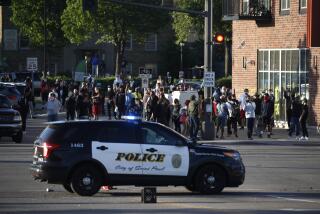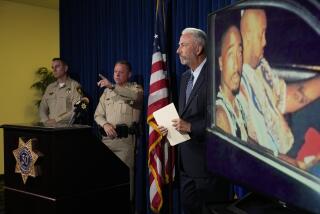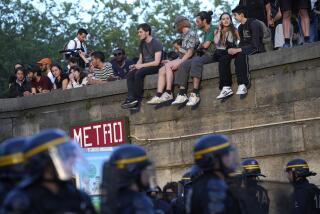Minneapolis Race Calm Shattered by Shooting : Civil rights: A black gang member is fatally shot in the back. Hostility simmers between police and community activists.
- Share via
MINNEAPOLIS — The black man had a gun. No, he didn’t have a gun. He was shot in the chest. He was shot in the back. He was trying to escape. He was going to shoot.
All that is known for sure is that the black man is dead, shot--it is now clear, in the back--by a white policeman. It is a street-corner tableau played out with chilling frequency in city after city, often with the predictable results: controversy, protests, calls for investigations.
What is different this time is the setting--Minneapolis, a city relatively free of the debilitating racial and social problems that beset many urban areas, a city known for its liberalism and one with only a minuscule black population.
But the police shooting of a young gang member, coming after a string of other incidents involving the police, has raised racial tensions to the highest level in recent memory, sparking police fears of retaliation and damaging community trust in the department.
Since the shooting last Dec. 1, the police have received reports of contracts being placed on officers by youth gangs, some African-American leaders have counseled crime witnesses not to cooperate with law enforcers and community pressure has forced the unprecedented appointment of a special investigator to aid in the probe of the shooting.
Relations between police and the black community “are certainly as tense as it’s ever been here,” said Police Chief John Laux. “There’s no time in my 23 years that it has been any greater.”
The controversy comes at a time of increased activity by violent, drug-dealing youth gangs and also concern in the black community that the overwhelmingly white police force has been overzealous and disrespectful of black people’s rights.
On the positive side, Laux said the controversy has served for the first time to open channels of communication between the department and segments of the black community concerned about soaring crime. “I’m encouraged that we’re making progress,” he said.
He acknowledged, however, that distrust of the police is so high that some black leaders don’t want it known publicly that they are meeting with him.
Anger reached a high level two years ago when an elderly couple died in a fire caused by a diversionary grenade ignited by police during a botched drug raid. Police said they didn’t know the couple were in the apartment.
That incident was followed nine weeks later by what is known locally as the “Embassy Suites Hotel Incident.” Black college students said they were beaten by police breaking up a party at the downtown hotel. Five blacks were charged with disorderly conduct, but four later were acquitted.
Other alleged police misconduct since then has kept tensions high, with some black leaders alleging that police officers are routinely abusive to nonwhites.
In the current incident, Tycel Caprice Nelson, 17, was fatally shot in the back Dec. 1 by a police officer responding to reports of a loud party in a neighborhood on the city’s north side. While officers were en route, there were reports of gunshots being fired in the area.
At the scene, Officer Dan May chased Nelson, who he alleges was carrying a handgun. Nelson at one point turned and raised his gun, according to May, and that was when the officer let go a shotgun blast.
Charges of a police cover-up were fueled by discrepancies between an early police finding that the youth was shot in the chest in self-defense and the later acknowledgement that Nelson actually had been shot in the back.
Things were further complicated by the refusal of 16 people who were at the party and who claimed they witnessed all or part of the incident to cooperate with police.
Instead, in a development similar to the Tawana Brawley case in New York, they have taken as advisers three controversial activists who have contended repeatedly that the police department and county prosecutors cannot be trusted to conduct a fair investigation.
“The witnesses say (Nelson) didn’t have a gun,” said Spike Moss, one of the advisers. “They’ve been saying that from day one.”
Police said Nelson was a member of the Disciples youth gang, but people who knew him say the youth recently had joined an organization that helps young gang members “find themselves.”
“He was a very quiet kid,” Moss said, “not any trouble to anybody. He was trying to put his life together.”
But he added that even if Nelson was a gang member it shouldn’t matter. “If he was Al Capone it’s illegal to murder him,” said Moss, who alleges that police officers “ran (Nelson) like a rabbit and took target practice at him.”
Such inflammatory rhetoric causes some police officers, such as Lance Zentzis, president of the Police Officers Federation of Minneapolis, to denounce Moss and others.
“I think these people are playing this incident and others like this for their own personal goals,” Zentzis said. “Some of these people, if they were white, they’d be in the Ku Klux Klan. They’re as guilty of promoting racism as anybody in this city.”
Laux said Moss and fellow advisers Randy Staten and the Rev. Jerry McAfee have been irresponsible in their handling of the matter and said many false rumors surround the case. But even Laux admits that the full story of what happened that icy night may never be known.
“That’s what’s so frustrating in this case--there are so many loose ends,” he said. “I can’t give the community answers because they’re not to be had and I don’t know that they’ll ever be had.”
For example, two people had been shot and wounded at the scene of the party before police arrived. The only gun recovered was the one found “a matter of feet” from Nelson’s body, Laux said.
One bullet had been fired from the gun, but police can’t determine if that gun wounded the youths at the party because they can’t recover the bullets that struck the youths. One passed through its victim and was never recovered. The other bullet is lodged in its victim in a sensitive area and cannot be surgically removed.
Police can’t even pin down where the two people were shot because witnesses won’t cooperate and the shooting victims were “stuffed into a cab and the driver was told to take them to the hospital” before the police even arrived on the scene, Laux said. In addition, no usable fingerprints were found on the gun found near Nelson’s body.
Moss said the so-called witnesses will cooperate now that William McGee, a trusted black lawyer, has been appointed as special investigator. Moss said they didn’t cooperate earlier because they didn’t trust the police.
“I know William McGee will do everything in his power to get at the truth without being biased,” said McAfee.
But Zentzis, the police union official, said he is not so sure. Noting that McGee has himself twice filed brutality claims against the Minneapolis police, he questioned whether he can be fair.
Zentzis also complained that McGee’s presence during grand jury proceedings might make witnesses afraid to testify truthfully for fear their testimony will be repeated to the wrong people. “All it takes is one witness to come forward and then we find out that witness is dead in a day or two,” he said. “That would be devastating” to the investigation.
The rise of violent youth gangs is a fairly recent occurrence in this comfortably affluent city in which 8% of the population is black. (Six percent of the police force is black, according to Laux, who said he is ardently recruiting minorities.) Laux, who became chief about two years ago, blames the refusal of his predecessor to acknowledge the growing gang problem in the late 1980s for allowing gangs to gain a foothold.
Now, says Zentzis, “the gangs are controlling half the city . . . there’s a lot of fear in the community.”
Laux said informants had told police that gang contracts had been placed on certain officers. “A couple of times they even gave times and locations when officers were going to be attacked,” he said.
Shortly after the Nelson shooting, police officers reported being fired at. McAfee, one of the activists, said that since the alleged attack, he receives telephone calls “every other day” from people alleging they have been beaten by police in retaliation.
Laux accepts part of the blame for the increased tension. “I erred,” he said, in hastily announcing that May acted properly in shooting Nelson and that the youth had been shot in the chest.
He said the forensic investigation wasn’t complete when he made the announcement. Investigators initially mistook exit wounds in Nelson’s chest for entry wounds.
“That’s hard for the community to accept and I realize that,” he said. “It’s a big credibility problem.”
More to Read
Sign up for Essential California
The most important California stories and recommendations in your inbox every morning.
You may occasionally receive promotional content from the Los Angeles Times.












